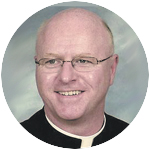
Msgr. Joseph Prior
(See the readings for the Fourth Sunday of Easter, April 25)
The 2020 movie “Greyhound” is based on a 1955 novel by C.S. Forrester. The plot follows the trans-Atlantic crossing of a convoy group of supply ships. The crossing takes place in 1942 during the Battle of the Atlantic. During the crossing the convoy is attacked numerous times by submarines. The naval escort is lead by Commander Ernest Krause whose command is the focus of the story. He is steadfast and committed to protecting the convoy.
One of the images used to convey this in the movie is his eating, or rather not being able to eat. Every time the steward brings his meal to the bridge so that he can eat, something comes up to prevent it. At one point an untouched tray crashes to the floor reminding the viewer that the captain has not eaten. Another symbol for stressing the captain’s commitment was at one point well into the crossing, he changes his boots for slippers. As he takes the boots off, his feet are bloodied — from standing so long.
As the convoy comes out of danger, the captain is ready to hand off command to another officer. It is at this point the crew realize that it has been 48 hours since he last relinquished command. As the captain returns to his cabin, he kneels down and prays before getting into bed. The title of the novel on which the movie is based is “The Good Shepherd.”
[hotblock]
The captain in the novel-turned-movie is committed to helping the crew, the convoyed troops, ships and supplies to their destination. He gives of himself, putting their safety and protection first. He sacrifices his own needs for the good of the others. The title for the novel comes from the Scriptures. The two most powerful uses of this title for God are in John 10 and Psalm 23. Most of us are readily familiar with these passages. The one from John is used for this Sunday’s Gospel.
Jesus says: “I am the Good Shepherd.” In Psalm 23, which begins “The Lord is my shepherd, there is nothing I shall want,” God is the shepherd who leads his flock to good pastures. He leads, guides, nourishes and protects. Jesus is now saying that he is that shepherd. He speaks of things we have already seen, heard and encountered. He knows his sheep and calls them by name. They know him and follow him.
All this will lead to his laying down his life for the sheep and he will take it up again. Jesus emphasizes this last point by restating it: “No one takes it from me, but I lay it down on my own. I have power to lay it down, and power to take it up again.”
Jesus is the Good Shepherd who loves his sheep, his flock, so much that he lays down his life for them, for us. And when he raises himself up, he raises the flock with him so that they too might be with him in life and love. We continue to celebrate this during the Easter season.
The first reading for today’s liturgy comes from Acts of the Apostles as do all the first readings from the Easter Season. Acts once again proclaims Jesus as crucified and risen. He is the “stone rejected by you, the builders, which has become the cornerstone.” He boldly proclaims: “there is no salvation through anyone else, nor is there any other name under heaven given to the human race by which we are to be saved.” Jesus, the Good Shepherd, saves us. He leads us through death to life.
[hotblock2]
Sometimes in life it might seem like we are on one of the troop convoy ships mentioned in the movie above. Sometimes it might seem like we are stuck waiting. The ship is moving but it is dangerous, not only from the sea or forces of nature. It is good at these times to keep our focus on Jesus through prayer and the sacraments. He is here leading us and protecting us. The forces that sometimes come upon us from outside or within have no real power when Jesus is present, and he always is.
The shepherd/flock theme is an image, a symbol which helps us visualize or conceptualize the relationship. The second reading moves beyond symbol to a deep reality that comes about through the paschal mystery and baptism. Through baptism we are sacramentally or mysteriously united with Christ Jesus. The water is poured and the words are spoken. We can hear and see and feel this.
What we can only see through the eyes of faith is that we are now one with Christ in a union so deep and penetrating that it transforms us. We are one with Christ. Hence, we are now children of God as Jesus is the Son of God. We have entered into the very life of God, divine life, eternal life. This is the destination to which the Good Shepherd leads us.
The end of the “Greyhound” story is seen when the convoy sails into safe waters off the coast of Ireland. As mentioned above, the captain goes to his cabin, kneels and prays. Above his head is a plaque containing a quote from the Scriptures, from Hebrews 13:8: “Jesus Christ is the same yesterday, today and forever.” Jesus is our Good Shepherd. In him we have life.
***
Msgr. Joseph Prior is pastor of Our Lady of Grace Parish, Penndel, and a former professor of Sacred Scripture and rector of St. Charles Borromeo Seminary.
PREVIOUS: Fighting words from an Irish saint
NEXT: Readings of the Holy Mass – Fourth Sunday of Easter



Share this story